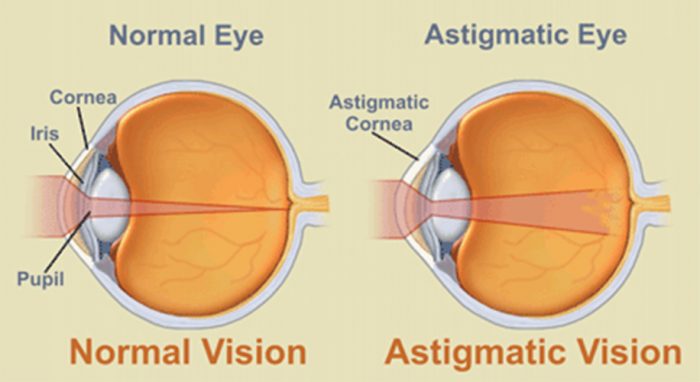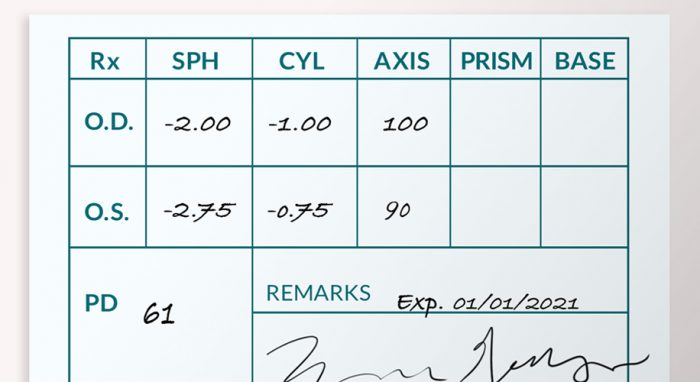All About Astigmatism
- BY Dr. Mori Goodyear
- IN Eye Health
This post was updated on May 19, 2023
What is Astigmatism?
Astigmatism is a common eye condition that causes blurry or distorted vision due to an irregularly shaped cornea or lens.
Astigmatism affects how the eye focuses light. In a normal eye, the cornea and lens at the front of the eye are round and evenly curved, like a basketball. However, in an eye with astigmatism, the cornea or lens is irregularly shaped, like a football or rugby ball. This causes light to be focused unevenly on the retina, the part of the eye that senses light and sends signals to the brain. As a result, people with astigmatism often have blurry or distorted vision, as well as other symptoms like eyestrain, headaches, and difficulty seeing at night.
Astigmatism can be diagnosed through a routine eye exam, and it can be corrected with eyeglasses, contact lenses, or refractive surgery.

What Are Common Symptoms Of Astigmatism?
Astigmatism is so common that almost all of us have it to some degree. The causes are predominantly genetic and can increase or decrease with age. Outside factors like surgery, eye disease, or an injury can also cause you to develop an astigmatism.
With the naked eye, you likely won’t notice astigmatism in your eye or in the eyes of others. Just like nearsightedness or farsightedness, astigmatism isn’t a “visible” condition. That said, there are some common symptoms that may be signs of astigmatism, such as:
- Blurry vision
- Eye strain
- Squinting to see near or far images
- Difficulty focusing on printed words
- Double vision
- Headaches
If you’re experiencing any of these symptoms, you should make an appointment with your eye doctor to get tested for astigmatism.
 Image source: Kowa Optimed Eye Care
Image source: Kowa Optimed Eye Care
How To Diagnose Astigmatism?
In order to determine if you have astigmatism, your eye doctor will perform a comprehensive eye exam by measuring how effectively your eyes can focus light. Several things that he/she will test include:
- Visual acuity – this is the basic vision test that we are most familiar with where you read a series of letters on a distance chart. A result of 20/20 means perfect vision, while a visual acuity of 20/40 means you would have to be 20 feet away to clearly read a letter that should be visible at 40 feet away.
- Keratometry – this type of test is used to measure the curvature of your cornea by focusing a circle of light on your cornea and measuring its reflection.
- Refraction – using a phoropter, your doctor places a series of lenses in front of your eyes to measure how they focus light. The power of the lenses is adjusted to determine the measurement of corrective lenses that would give you the clearest vision. The final measurement is used to provide an eyeglass or contact lens prescription that corrects for nearsightedness, farsightedness, and astigmatism.

How to Read Astigmatism Correction On Your Prescription?
If you have an astigmatism correction on your prescription, you’ll have both CYL and AXIS values for one or both eyes. You’ll see a minus (-) or plus (+) number in the CYL section (If your eye doctor gave you a handwritten prescription, the CYL section would be the second series of numbers followed by the AXIS.).
The AXIS number represents the degree of the angle at which the cylinder is placed on your corrective lenses. Your AXIS number will be a whole number between 1 and 180. For example, if your AXIS number is 180 then your astigmatism is corrected by placing the cylinder horizontally on your lens. Many people’s prescriptions fall in between these right angles, but most commonly near 180 or 90 degrees.
Tip: If you don’t see a number in the AXIS field, but have a CYL value, contact your eye doctor since this is likely an error.
When you look at the AXIS number on your prescription, you may notice some zeroes before the number, such as 005 or 090. This translates to AXIS numbers of 5 and 90. The zeroes are there for clarity, to easily distinguish between, say, 009 and 090.
Ordering Glasses Using Your Astigmatism Prescription
The highest CYL number that we can correct at Zenni is +/-6.00. Since the majority of the lenses we offer accommodate this CYL correction, you have plenty of frame options to choose from.
There is an extra-strength charge on orders of single-vision lenses when the prescription indicates strong astigmatism since these are more complicated to produce. Bifocal or progressive lenses with high CYL numbers that call for strong astigmatism corrections do not have any extra charges.
If you’re in the market for some new frames that can accommodate astigmatism corrections, discover our newest eyeglasses frame styles.
About the Author: Dr. Mori Ahi, O.D.
Dr. Mori has over 10 years of experience in eye care. She earned her undergraduate degree from UCLA and her optometry degree from the New England College of Optometry. She has worked in a variety of eye care settings and is passionate about helping her patients find a great pair of affordable glasses